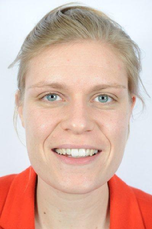Smart polymer brushes in nanopores: Towards controlled molecular transport through pore-spanning biomembranes
Promotion date: December 12.
Promotor: Prof.dr. G. Julius Vancso
AssistantPromotor: Dr. M. Gabriella Santonicola
| The aim of this thesis was the development of stimulus responsive polymer brush structures as micropore switches for molecular screening. This was achieved by grafting pH‐responsive poly(methacrylic acid) (PMAA) brushes from nanoporous platforms that were then integrated in functional assays for membrane proteins. Several properties of the smart PMAA brush contributed to the functionality of such protein assays. Controlled transport of ions and molecules through nanopores, support of pore-spanning artificial lipid bilayers and positioning of membrane proteins over the pores, were achieved with the explored PMAA‐brush functionalized platforms. |
Was your research application driven?
My research was part of a European project in which various groups participated, ultimately to develop new screening methods on membrane proteins for drug development. Our task in this project was the functionalization of nanoporous platforms, which are the base for the membrane protein assays. For this a pH-responsive polymer brush was used in order to open and close channels of 200 nanometers in diameter to control transport. A lot of issues involved are quite fundamental in character, as the velocity of swell and collapse behavior of the polymer brushes inside the pores, depends on various parameters, for example the density distribution of the polymer brushes inside the pores.
My work was experimental in nature, trying to measure and differentiate various transport aspects of the underlying mechanisms involved. The lipid bilayer formation and the integration of proteins on top of the functionalized platforms, was an experimental challenge.
In the future a redox-responsive polymer brush driven device, is favorable to open and close channels independently of one another. It will then hopefully be possible to screen arrays of various membrane proteins with a variety of analytes.
Were there some important moments along the PhD project that you recall?
First of all the nanoporous platforms proved to be successfully functionalized in showing the desired swell and collapse behavior, as the polymer brushes in the pores showed this under the influence of pH-fluctuations. This we could image with atomic force microscopy.
More difficult was the demonstration of the smart polymer brush actually controlling transport through the channels. By using fluorescent techniques to measure the amount of fluorescent molecules passing through the channels, we could actually demonstrate channels being blocked or opened by the responsive polymer chains. Also the conductivity for certain ions through the smart polymer brush functionalized channels, could be controlled by switching the pH. It was a great feeling to demonstrate these transport mechanisms.
The last challenge was the artificial lipid bilayer formation and integration of membrane proteins, on top of the PMAA brush functionalized nanoporous platforms. Lipid bilayer formation was succeeded with colleagues in Switzerland, but the integration of functional membrane proteins is still a challenge. The final goal to develop and test new drugs by screening membrane proteins, is still quite far beyond our reach.
Were you able to publish some nice articles?
Articles appeared in Langmuir and ACS Applied Materials and Interfaces. Also Nanoscale accepted an article recently.
During the project I presented my findings in meetings all over Europe, for my colleagues in this European project, and I was twice a speaker on the Dutch Polymer Days. Here I won a lecture prize. I visited several other conferences where I presented posters.
In what way did you develop personally as a researcher and scientist?
The opportunity to work on this PhD project came my way quite unexpectedly. I’m glad I took this opportunity as it was a privilege to learn new skills for another four years. Also I learned to deal with the pressure and setbacks during a lengthy process like this. It was hard to keep believing in good results along the way, but my three publications proved I did succeed doing so.
What are your future plans?
I am planning to teach pupils in secondary schools, as I can contribute to society in a very direct way then. Already during my minor project as a BSc. Student, I did follow courses on knowledge transfer in teaching situations. Since a while the opportunity exists for PhD students at the UT to obtain the first degree of competence. I really would love to go and work in a secondary school in the vicinity of Enschede. As a former researcher I hope I can enthuse pupils for chemistry and some in pursuing a career in science.
What, in your opinion, is important for MESA+ to stay successful in future?
I believe a good mix exists now in PhD’s coming from within The Netherlands and from abroad. The Dutch students are more used to work together in projects and to reach a certain goal. On the other hand, foreign students contribute to the quality as their education system is sometimes more based on gaining knowledge. I hope the scholarship system will not prevent Dutch students to work in PhD projects. The Dutch government should keep it attractive to choose this career path

